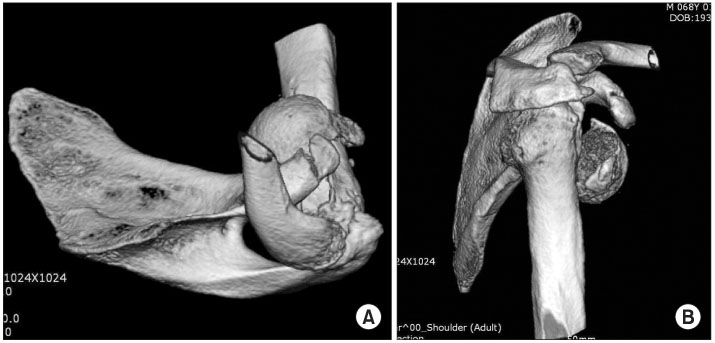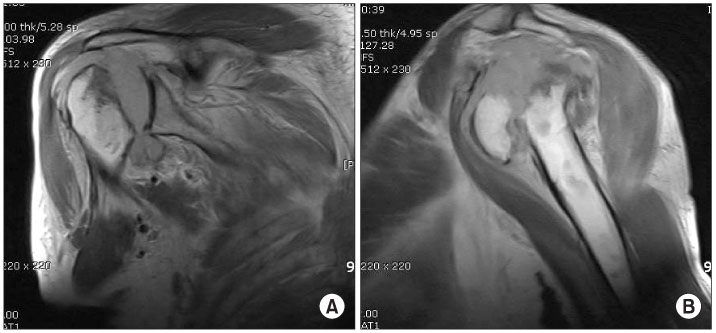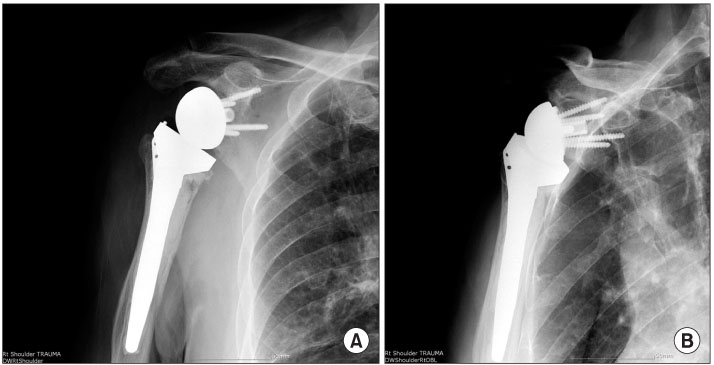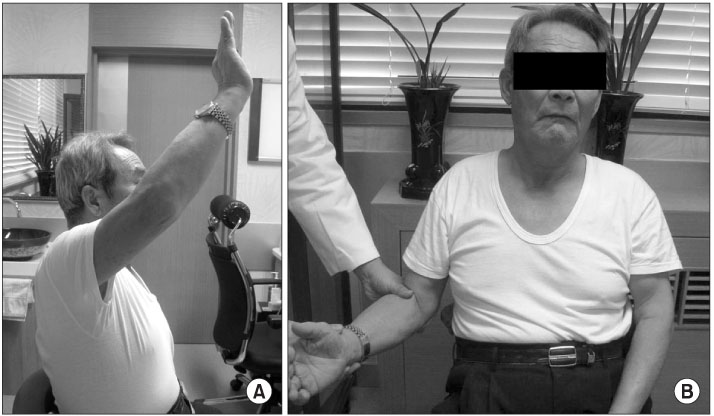J Korean Orthop Assoc.
2011 Apr;46(2):152-157.
Reverse Shoulder Arthroplasty for Humeral Head Fracture with Massive Rotator Cuff Tear in Elderly Patient
- Affiliations
-
- 1Department of Orthopedic Surgery, Daejeon St. Mary's Hospital, The Catholic University of Korea, Daejeon, Korea. oskn@catholic.ac.kr
Abstract
- There are several methods to treat anatomic neck fracture of humerus in elderly patients. It is not easy to obtain optimal clinical or radiological results because of unstable fixaton of fractured site attributed to multifractured osteoporotic tuberosities and combined massive rotator cuff tears in these patients. These factors often lead to high failure rate of implantation. Alternative methods of treatment have been proposed to reduce complications and improve shoulder functions. Reverse shoulder prosthesis was originally designed for patients with cuff tear arthropathy. Indications for reverse shoulder arthroplasty have expanded with initial success. However, there are few reports to perform reverse shoulder prosthesis in proximal humerus fracture. We performed reverse shoulder arthroplasty in a 74-year-old man with right anatomic neck fracture of humerus and concomitant massive rotator cuff tear.
Figure
Reference
-
1. Zyto K, Ahrengart L, Sperber A, Törnkvist H. Treatment of displaced proximal humeral fractures in elderly patients. J Bone Joint Surg Br. 1997. 79:412–417.
Article2. Baron JA, Karagas M, Barrett J, et al. Basic epidemiology of fractures of the upper and lower limb among Americans over 65 years of age. Epidemiology. 1996. 7:612–618.
Article3. Compito CA, Self EB, Bigliani LU. Arthroplasty and acute shoulder trauma. Reasons for success and failure. Clin Orthop Relat Res. 1994. (307):27–36.4. Martin TG, Iannotti JP. Reverse total shoulder arthroplasty for acute fractures and failed management after proximal humeral fractures. Orthop Clin North Am. 2008. 39:451–457.
Article5. Prakash U, McGurty DW, Dent JA. Hemiarthroplasty for severe fractures of the proximal humerus. J Shoulder Elbow Surg. 2002. 11:428–430.
Article6. Schai P, Imhoff A, Preiss S. Comminuted humeral head fractures: a multicenter analysis. J Shoulder Elbow Surg. 1995. 4:319–330.
Article7. Edwards TB, Williams MD, Labriola JE, Elkousy HA, Gartsman GM, O'Connor DP. Subscapularis insufficiency and the risk of shoulder dislocation after reverse shoulder arthroplasty. J Shoulder Elbow Surg. 2009. 18:892–896.
Article8. Tischer T, Rose T, Imhoff AB. The reverse shoulder prosthesis for primary and secondary treatment of proximal humeral fractures: a case report. Arch Orthop Trauma Surg. 2008. 128:973–978.
Article9. Sirveaux F, Favard L, Oudet D, Huquet D, Walch G, Molé D. Grammont inverted total shoulder arthroplasty in the treatment of glenohumeral osteoarthritis with massive rupture of the cuff. Results of a multicentre study of 80 shoulders. J Bone Joint Surg Br. 2004. 86:388–395.10. Boileau P, Krishnan SG, Tinsi L, Walch G, Coste JS, Molé D. Tuberosity malposition and migration: reasons for poor outcomes after hemiarthroplasty for displaced fractures of the proximal humerus. J Shoulder Elbow Surg. 2002. 11:401–412.
Article
- Full Text Links
- Actions
-
Cited
- CITED
-
- Close
- Share
- Similar articles
-
- Reverse Total Shoulder Arthroplasty in the Massive Rotator Cuff Tear
- Massive Rotator Cuff Tears: Arthroplasty
- Rapidly Progressive Osteonecrosis of the Humeral Head after Arthroscopic Bankart and Rotator Cuff Repair in a 66-Year Old Woman: A Case Report
- Deltoid Muscle Rupture Combined with Massive Rotator Cuff Tear
- Bilateral acromial stress fractures in a patient with a massive rotator cuff tear







